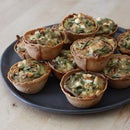Introduction: Making Mycelium
I am interested in bio materials that can return to the earth to support a circular economy. This project is the start of a larger project that will look at home made tools and products using waste food and bio materials to engage people to understand more about the product journey of the items they have in their home, ultimately reducing their consumption and impact on the environment.
Mycelium is the reproduction part of a fungus, consisting of a mass of branching, thread-like hyphae.
Mycelium is a fast growing organism and one of its primary uses is to decompose organic compounds. Petroleum products and some pesticides are organic molecules as they are built on a carbon structure, so they can be a potential carbon source for mycelium. This means it has the potential to consume such pollutants from their environment, (unless the chemicals are toxic to the fungus) which is a great potential for the circular economy to reduce the impact of plastics on the environment. As part of my research I will continue experimenting with the potential of this material to make a big difference to the material world.
This instructable guides you to making a material that is open for experimentation, it is not an end product. Get creative, and share your results.
You will need:
A sealable container - a glass tupperware is perfect
Corrugated cardboard
mushroom with a large base - I used King Oyster mushrooms
A scalpel or small knife
A dark place to store - a bucket is useful
Step 1: Prepare the Growing Environment
Cut the cardboard into pieces that fit well into the container.
Stack them up inside and fill with water, you may need to weight them down so they are fully immersed under the water. Soak for 20-30 minutes so the layers of the cardboard will separate easily.
Drain then separate the layers so you have sheets of corrugated layers and sheets of flat card.
Step 2: Cut Pieces of Mushroom
Take your mushroom and scalpel to cut tiny slices of the base. Only use the base as this is the reproduction part which will grow within the cardboard.
The third picture gives you a sense of scale to guide you with the size of each piece, make sure they are thin layers.
This will take you a while. I will be experimenting with using a food blender to see if this process can be sped up and if it effects the growth of mycelium.
Step 3: Add the Layers
Add a layer of cardboard to the bottom of the container, as you form the layers you need to have a corrugated sheet and a flat sheet, the corrugated layer gives the mycelium space to grow into. Alternatively you can use corrugated sheets for all layers.
Spread the little pieces of mushroom evenly and fairly close together and cover with a sheet of cardboard.
Repeat until you have filled the container and the layers are filled with mushroom.
Step 4: Store and Grow
Now you have the container ready, close the lid and store in a dark place at room temperature. Each day open the box to let some air out. Without any air exchange carbon dioxide levels build up and your mycelium will have stunted growth.
I put the container in a black bucket so it was in a dark place.
Step 5: Watching It Grow
This is the exciting part. After a few days the mycelium will start to appear through the edges of the cardboard, this is why a clear box is the best as it allows you to see whats happening. It appears to seep through the cardboard, filling in all the gaps and holes.
Once the mycelium has reached a level you are happy with (I am still waiting for mine to completely surround the cardboard) you can heat the block to stop it growing any further. As my mycelium hasn't stopped growing I am yet to experiment with the heat process and the end product, when that happens I will update my instructable to explain my development. As I said in the introduction this is a work in progress project.
Thanks for reading.













